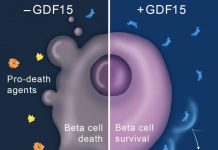August 2003 - Drivers with type-1 diabetes reported higher numbers of driving mishaps according to a multi-center study led by researchers at the University of Virginia Health System. The study investigated whether or not diabetes treatments to control blood sugar level are associated with increased risks for driving mishaps. The results will be published in the August edition of Diabetes Care.
Hypoglycemia, or low blood sugar, occurs when blood glucose levels drop too low to properly fuel the body. A person with diabetes can become hypoglycemic by taking too much insulin or diabetes medication or by skipping meals. If blood sugar levels continue to fall, the lack of adequate glucose begins to impair brain and nervous system functions. Additional symptoms appear that affect behavior and judgment including confusion, blurred vision, mood changes, weakness and poor coordination.
�Becoming hypoglycemic while driving can prove hazardous,� said Daniel Cox, professor of psychiatric medicine at U.Va. Health System and principal investigator of the study. �Previous studies have looked at this problem but they did not distinguish between type 1 or type 2 diabetes and other factors that are important to a diabetic�s risk for driving mishaps.�
This study examined patients at diabetes specialty clinics at five U.S. and four European cities. Adults with type-1 diabetes, type-2 diabetes and non-diabetic adults were asked to complete an anonymous questionnaire.
The drivers with type-1 diabetes reported significantly more crashes, moving violations and hypoglycemic episodes than did patients with type-2 diabetes regardless of whether they used insulin. The type-2 diabetes group had driving mishap rates similar to non-diabetic drivers. However, only 20 percent of the drivers with type-1 diabetes were at increased risk of driving mishaps.
Continue Reading Below ↓↓↓
�We need to understand which diabetic drivers are at high-risk and why, in order to eventually develop a treatment program to lower this risk,� Cox said. �This research does not set out to restrict diabetic drivers, but instead provides information that physicians can use to talk with their patients about hypoglycemia and driving.�
The research also points out that drivers with type-1 diabetes are only one of several driver groups who are at increased risk of driving mishaps. Other groups include those younger than 21 and older than 60, those with attention deficit/hyperactivity disorder, those with sleep apnea and abusers of alcohol.
Cox recently received a $2.8 million grant from the National Institutes of Health to study the additional effects of hypoglycemia and driving. He is currently working with mathematician, Boris Kovatchev, to find an algorithm that can predict the onset of hypoglycemia.
�Ultimately, we want to reduce the incidence of hypoglycemia of at-risk drivers in order to reduce occurrences of driving mishaps,� Cox said.
Other institutions that participated in the study include the Joslin Diabetes Center in Boston, Mass., the University of Chicago in Ill., University of Louisville in Ky., Washington University in St. Louis, Mo., SUNY Institute of the Diabetes Academy in Mergentheim, Germany, and the Royal Infirmary in Edinburgh, Scotland.
Source: University of Virginia









